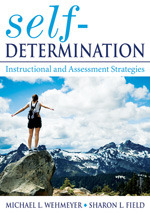Self-Determination
Instructional and Assessment Strategies
- Michael L. Wehmeyer - University of Kansas, USA
- Sharon L. Field - Wayne State University, USA
"There is not available a more comprehensive book in the area of self-determination."
—Melinda Pierson, Department of Special Education
California State University, Fullerton
"Unique because it provides direction for teaching and supporting self-determined behavior across all age groups and also within the general education classroom and curricula."
—Marianne Mooney, Senior Research Associate
TransCen, Inc., Post-Secondary Learning and Careers
Give students with disabilities powerful tools for success in school and in life!
Michael Wehmeyer and Sharon Field present research-proven instructional strategies that empower special needs students at all grade levels to make their own decisions.
Self-Determination offers detailed and current practitioner-oriented approaches in combination with extensive teacher reproducibles—all within the context of inclusion, standards-based reform, and access to the general curriculum. Linked to the IDEA requirement for individualized transition plans, this user-friendly resource assists practitioners in teaching the skills necessary for making decisions about employment, job skills, further schooling, and independent living. Educators will discover how to:
- Encourage students to become their own advocates by practicing assertive behavior
- Use needs-assessment techniques to determine the level of instruction required for each student
- Teach effective choice making, problem solving, and goal setting
- Support both families and fellow educators in their efforts to teach self-determination skills
Special education teachers, general educators, and administrators will find this handbook an invaluable guide for helping students establish their own goals and plan for a strong and healthy future!
"There is not available a more comprehensive book in the area of self-determination."
"Unique because it provides direction for teaching and supporting self-determined behavior across all age groups and also within the general education classroom and curricula."
Sample Materials & Chapters
Preface_Self Determination_Wehmeyer
Chapter 1_Self Determination_Wehmeyer
